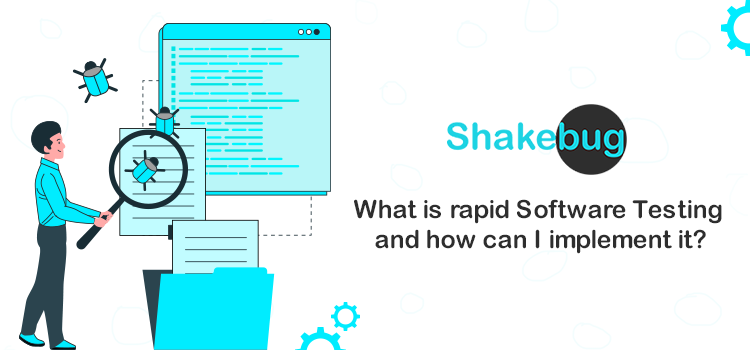Rapid testing is one of the mobile app testing methods that focuses on quickly identifying and fixing bugs in the system. It employs techniques such as automation, exploratory testing, and risk-based approaches to detect potential system problems before they become major problems. This testing method can be used for both manual and automated tests, allowing developers to find errors more quickly than traditional methods.
To incorporate rapid software or app testing into your app development process, you must first develop an effective test plan that specifies what needs to be tested and how it will be accomplished. Use tools such as bug tracking systems or static code analysis tools to help streamline the process and identify issues early in the development cycle.
Understanding Rapid Software Testing
A. Key Principles of RST
Rapid Software Testing (RST) is a testing methodology that focuses on finding problems quickly and efficiently. It emphasises the importance of understanding the context in which software will be used and how to communicate with stakeholders about test results effectively.
The key principles behind this approach include focusing on risk-based testing, using exploratory techniques, developing heuristics for problem-solving, and being mindful of time constraints while still ensuring quality assurance.
B. Differentiating RST from Traditional Testing Approaches
RST is a method of testing that focuses on quick results and efficient use of resources, while still ensuring quality assurance. It differs from traditional testing approaches by being more agile and adaptive to changing requirements, as well as focusing on risk-based tests rather than exhaustive test cases.
Additionally, it emphasizes communication between testers and developers so that issues can be addressed quickly and efficiently.
C. Benefits of Implementing RST
Implementing Rapid Software Testing (RST) can offer many benefits to organizations. RST helps reduce the time and cost of software testing, as well as improve quality assurance processes. It also allows for more efficient use of resources by focusing on high-priority tests first and reducing unnecessary testing efforts.
Additionally, it provides a better understanding of how users interact with applications so that developers can make improvements accordingly. Finally, implementing RST enables teams to work together in an agile manner which increases collaboration between departments while still ensuring product quality is maintained throughout the development process.
Steps to Implement Rapid Software Testing
A. Embracing Agile Methodologies
Embracing agile methodologies is a critical step in implementing rapid software testing. Agile development focuses on delivering working software in a timely and efficient manner, making it ideal for rapid software testing. Teams can use an iterative approach to identify areas of improvement in their codebase and make changes as needed without sacrificing quality and speed.
Furthermore, by utilizing automated tests such as unit and integration tests, teams can ensure that any new features added are thoroughly tested before being released into production.
B. Building a Cross-functional Team
Putting together a cross-functional team is a critical step in implementing rapid software testing. To ensure that all aspects of the project are considered when making decisions, this team should include members from various departments such as development, QA, and operations.
Representatives from each department should also be on the team to provide feedback on how to best implement the testing process. A diverse group of people with different perspectives will aid in the development of better solutions to any issues that may arise during the testing phase.
C. Test Automation Integration
Implementing rapid software testing requires the integration of test automation. This involves automating tests to ensure that they can be run quickly and accurately, allowing for faster feedback on any changes made in the codebase.
Test automation also allows testers to focus their efforts on more complex tasks while still ensuring quality assurance is maintained throughout development cycles. The use of automated tools helps reduce manual effort and time spent running tests, making it a great option for businesses looking to speed up their software delivery process.
D. Continuous Integration/Continuous Deployment (CI/CD)
One of the most effective ways to ensure quality and accuracy in software development is through Continuous Integration/Continuous Deployment (CI/CD). This process allows developers to quickly identify issues, test changes, and deploy new features without disrupting existing functionality.
CI/CD also helps reduce costs by automating tests that would otherwise have to be done manually. With a well-implemented CI/CD system in place, businesses can rest assured that their applications are running at peak performance with minimal disruption or downtime.
IV. Overcoming Challenges in Rapid Software Testing
Overcoming Challenges in Rapid Software Testing is a critical component of software development. It involves quickly and efficiently testing the system to ensure that it meets all requirements before being released into production. Rapid software testing presents several challenges, including ensuring accuracy, scalability, reliability, and performance.
To address these issues, organizations must invest in automated testing tools that can help them speed up their processes while maintaining quality assurance standards. Furthermore, they should focus on fostering a culture of continuous improvement by soliciting feedback from users and stakeholders throughout the development cycle.
Real-world Case Studies
Rapid Software Testing is a testing methodology that focuses on producing high-quality results in the shortest time possible. This method involves using real-world case studies to identify potential problems and quickly develop solutions. Companies can save money by lowering development costs while maintaining product quality assurance by using this method.
Real-world case studies are an essential component of rapid software testing because they provide valuable insights into how users interact with the product and which areas may require improvement or further optimization.
Tools and Technologies for Rapid Software Testing
Rapid Software Testing is a process that uses tools and technologies to test software quickly. It allows developers to find bugs in their code more quickly and improves the overall quality of the product. The primary goal of rapid software testing is to reduce manual testing time while maintaining accuracy and reliability.
This is possible through automation, which speeds up processes like regression testing and performance testing. Furthermore, it allows testers to spend more time on exploratory testing rather than spending too much time manually running repetitive tasks. Businesses can save money and time by reducing the costs of manual labour and using these tools and techniques for rapid software testing.
Measuring and Monitoring RST Effectiveness
Rapid Software Testing (RST) is a methodology for quickly and efficiently testing software. Measuring and monitoring RST effectiveness is an important part of the process because it ensures that quality results are achieved on time.
Metrics such as test coverage, defect density, cycle time, bug severity levels, customer feedback scores, and others are tracked. Teams can identify areas for improvement or potential issues by measuring these metrics regularly during development cycles.
Conclusion
In conclusion, Rapid Software Testing is a quick and efficient way to test software. It enables quick feedback on the quality of a product or service to make immediate improvements. The process can be used by both experienced and inexperienced testers because it provides clear guidelines that help ensure accuracy and consistency throughout the process. Furthermore, this method helps to reduce the costs associated with traditional testing methods while still providing reliable results.


